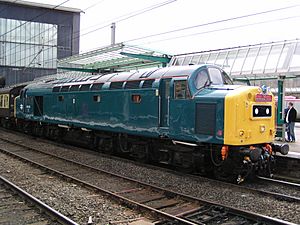British Rail Class 40 facts for kids
Quick facts for kids English Electric Type 4British Rail Class 40 |
|
 |
|
| 40145 at Carlisle on 27 August 2004, whilst working a charter train. This locomotive is the last remaining 'centre headcode' type Class 40. | |
| Power type | Diesel-electric |
|---|---|
| Builder | English Electric at Vulcan Foundry and Robert Stephenson and Hawthorns |
| Build date | 1958–1962 |
| Total production | 200 |
| Configuration | 1Co-Co1 |
| UIC classification | (1Co)'(Co1)' |
| Gauge | 4 ft 8 1⁄2 in (1,435 mm) |
| Wheel diameter | Driving: 3 ft 9 in (1.143 m) Idling: 3 ft 0 in (0.914 m) |
| Minimum curve | 4.5 chains (91 m) |
| Wheelbase | 61 ft 3 in (18.67 m) |
| Length | 69 ft 6 in (21.18 m) |
| Width | 9 ft 0 in (2.74 m) |
| Height | 12 ft 10 in (3.91 m) |
| Locomotive weight | 133 long tons (135 t) |
| Fuel capacity | 710 imp gal (3,200 L; 850 US gal) |
| Prime mover | English Electric 16SVT MkII |
| Transmission | DC generator, DC traction motors |
| Multiple working | ★ Blue Star |
| Top speed | 90 mph (140 km/h) |
| Power output | Engine: 2,000 bhp (1,490 kW) At rail: 1,550 hp (1,160 kW) |
| Tractive effort | Maximum: 52,000 lbf (231 kN) |
| Train heating | Steam generator |
| Locomotive brakeforce | 51 long tons-force (508 kN) |
| Train brakes | Vacuum |
| Career | British Railways |
| Number | D200–D399, later 40001–40199 |
| Axle load class | Route availability 6 |
The British Rail Class 40 was a type of powerful diesel locomotive used on British railways. These impressive engines were built by English Electric between 1958 and 1962. There were 200 of them in total! For a while, they were the most important diesel trains on the tracks.
Contents
Discovering the Class 40 Locomotives
The Class 40 locomotives were a big deal when they first appeared. They were part of a plan to replace old steam trains with newer, more modern diesel engines. These locomotives were strong and fast, making them perfect for pulling important passenger trains across the country.
Building the Mighty Class 40s
- These locomotives were built by a company called English Electric.
- They were made at two factories: Vulcan Foundry and Robert Stephenson and Hawthorns.
- The first Class 40s started running in 1958.
- The last ones were finished in 1962.
- In total, 200 of these locomotives were built.
A Change in Their Role
Even though the Class 40s were very successful at first, railway technology kept improving. Soon, even more powerful diesel locomotives were being made. These new trains could go faster and pull heavier loads. Because of this, the Class 40s slowly started to lose their jobs on the fastest passenger routes.
Working Hard for Many Years
- After being replaced on the main express lines, the Class 40s found new jobs.
- They started pulling other passenger trains, like those on less busy routes.
- They also became very important for moving freight (goods) around the country.
- These locomotives worked hard for many years in these roles.
The End of the Line
- By the mid-1980s, the Class 40s were getting old.
- Newer, more efficient locomotives were ready to take their place.
- The last Class 40s were officially retired from regular service in 1985.
- However, some of these amazing trains have been saved!
Class 40s Today
- Several Class 40 locomotives have been preserved.
- This means they are kept in special museums or heritage railways.
- Train fans can still see them and sometimes even ride behind them.
- They are a reminder of an important time in British railway history.
Images for kids









